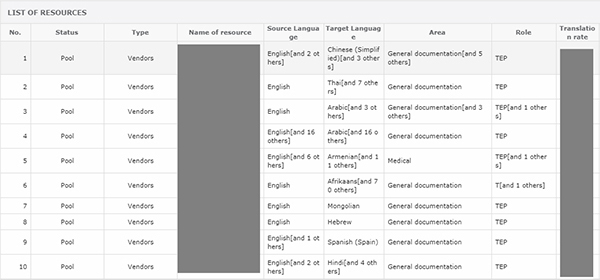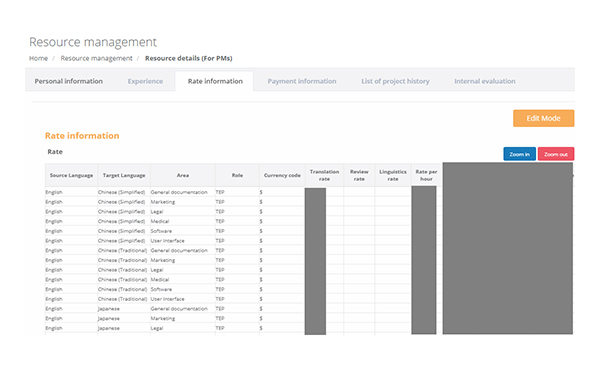

Technology


When we think about vendor management, most people automatically think of a list of vendors with a price list. It’s usually thought of as a simple allocation process handled by in-house staff or outsourced when necessary.
Vendor management isn’t an issue for small translation service providers with domain expertise in specific languages, where most of the work is handled in house. However, larger translation service providers with more customers and multiple projects happening at once may experience issues. How external resources are used becomes very important to meeting the turnaround times of multiple projects, and particularly when handling languages that aren’t directly supported in house. Therefore, this series of repeated processes must be carried out efficiently, either by hiring internal staff or managing vendors.
Generally, language service providers (LSPs) have teams of project managers (PMs), general managers, quality managers, and reviewers; when they don’t have internal translators on staff, they outsource the work. Multilingual language vendors (MLVs) rely heavily on external vendors to handle the high volume of work for the service it provides. Fully managing the work in house is too costly and a strong network of vendors is the key to survival.
ranslation involves language pairs, which is the translation of content from a source language to a target language. An LSP can focus on certain language pairs, such as Chinese-Japanese-Korean (CJK), and hire in-house staff accordingly. However, customers may request different languages, like Vietnamese, Taiwanese, or Indonesian, and not being able to handle a customer’s request can be seen as unprofessional and may even result in losing the customer. An LSP must be ready to handle requests outside their regular scope by having a diverse and agile vendor pool. Taking a proactive approach to searching for new vendors and maintaining a good pool of qualified vendors are some of a vendor manager’s most important responsibilities.
There are industry standards for the prices of language pairs. Clients consistently challenge the regular prices and ask for discounts. Therefore, it’s important for LSPs to have a range of vendors with different price ranges and it’s good to have vendors who are willing to reduce their rates. It’s the role of the vendor manager to manage their vendors on a regular basis and to negotiate unit prices, in order to maintain vendor relationships, or search for new vendors.
Vendor prices vary depending on the project type, project level, or language pair, and comparing these prices across vendors can be complex. An intuitive, meaningful price comparison will help you weigh the pros and cons, and find an ideal partner.
Anyone can do one-off work. However, it’s not possible to continue doing business without your customers’ trust and satisfaction. Similarly, vendors who carry out projects should regularly be evaluated. If they receive a low evaluation score, you should avoid using them simply because their price is low.
Every month, there are thousands of projects. Vendor managers need to manage their partners with low evaluation scores. In some cases, vendor managers may need to find new vendors to replace underperforming ones.
HansemEUG understands that vendor management is key to the success of an LSP. We have exclusively developed the Hansem Translation Vendor Management System (TVMS).
Hansem TVMS takes a data-based approach to vendor management, different from the traditional file-based approach. It’s systematized to help you find resources in a much faster, easier way. Also, all resources are evaluated by the project managers in charge so that individual resources can be evaluated in a meaningful way.
The features of Hansem TVMS are:
On the system, you can quickly search through registered resources to find a resource that meets your conditions for language, professional areas, price, and more.

PMs and managers can select a resource to see detailed information, such as their project history with HansemEUG and their evaluation scores.

HansemEUG is the first Korean company to comply with EU GDPR and carry out the necessary changes to our resource management system and project management process in order to protect individuals’ privacy and ensure the security of all personal data. We’ve upgraded our servers to incorporate all the required security and privacy measures.
For more information, refer to the following article posted at March 16, 2018. HansemEUG Ready for General Data Protection Regulation (GDPR)
Hansem Global is an ISO Certified and globally recognized language service provider. Since 1990, Hansem Global has been a leading language service company in Asia and helping the world’s top companies to excel in the global marketplace. Thanks to the local production centers in Asia along with a solid global language network, Hansem Global offers a full list of major languages in the world. Contact us for your language needs!
 Transforming B2C Sales Training with Gamification
04.14.2024
Transforming B2C Sales Training with Gamification
04.14.2024
 The Impact of Localization on Salesforce’s Success with Hansem Global
04.07.2024
The Impact of Localization on Salesforce’s Success with Hansem Global
04.07.2024
 Mastering Right-to-Left (RTL) Language Localization: Avoid the Top 5 Desktop Publishing (DTP) Mistakes for Global Success
04.03.2024
Mastering Right-to-Left (RTL) Language Localization: Avoid the Top 5 Desktop Publishing (DTP) Mistakes for Global Success
04.03.2024